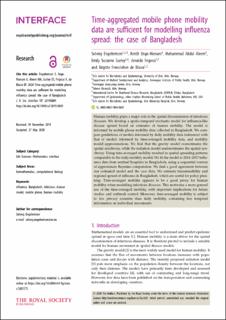| dc.contributor.author | Engebretsen, Solveig | |
| dc.contributor.author | Engø-Monsen, Kenth | |
| dc.contributor.author | Aleem, Mohammad Abdul | |
| dc.contributor.author | Gurley, Emily Suzanne | |
| dc.contributor.author | Frigessi Di Rattalma, Arnoldo | |
| dc.contributor.author | de Blasio, Birgitte Freiesleben | |
| dc.date.accessioned | 2021-03-11T08:53:02Z | |
| dc.date.available | 2021-03-11T08:53:02Z | |
| dc.date.created | 2020-07-21T09:08:10Z | |
| dc.date.issued | 2020 | |
| dc.identifier.citation | Journal of the Royal Society Interface. 2020, 17 (167), . | en_US |
| dc.identifier.issn | 1742-5689 | |
| dc.identifier.uri | https://hdl.handle.net/11250/2732749 | |
| dc.description.abstract | Human mobility plays a major role in the spatial dissemination of infectious diseases. We develop a spatio-temporal stochastic model for influenza-like disease spread based on estimates of human mobility. The model is informed by mobile phone mobility data collected in Bangladesh. We compare predictions of models informed by daily mobility data (reference) with that of models informed by time-averaged mobility data, and mobility model approximations. We find that the gravity model overestimates the spatial synchrony, while the radiation model underestimates the spatial synchrony. Using time-averaged mobility resulted in spatial spreading patterns comparable to the daily mobility model. We fit the model to 2014–2017 influenza data from sentinel hospitals in Bangladesh, using a sequential version of approximate Bayesian computation. We find a good agreement between our estimated model and the case data. We estimate transmissibility and regional spread of influenza in Bangladesh, which are useful for policy planning. Time-averaged mobility appears to be a good proxy for human mobility when modelling infectious diseases. This motivates a more general use of the time-averaged mobility, with important implications for future studies and outbreak control. Moreover, time-averaged mobility is subject to less privacy concerns than daily mobility, containing less temporal information on individual movements | |
| dc.language.iso | eng | en_US |
| dc.rights | Navngivelse-Ikkekommersiell-DelPåSammeVilkår 4.0 Internasjonal | * |
| dc.rights.uri | http://creativecommons.org/licenses/by-nc-sa/4.0/deed.no | * |
| dc.title | Time-aggregated mobile phone mobility data are sufficient for modelling influenza spread: the case of Bangladesh | en_US |
| dc.type | Journal article | en_US |
| dc.type | Peer reviewed | en_US |
| dc.description.version | publishedVersion | |
| dc.description.version | publishedVersion | |
| cristin.ispublished | true | |
| cristin.fulltext | original | |
| cristin.fulltext | original | |
| cristin.qualitycode | 1 | |
| dc.identifier.doi | 10.1098/rsif.2019.0809 | |
| dc.identifier.cristin | 1819963 | |
| dc.source.journal | Journal of the Royal Society Interface | en_US |
| dc.source.volume | 17 | en_US |
| dc.source.issue | 167 | en_US |
| dc.source.pagenumber | 15 | en_US |
| dc.relation.project | Norges forskningsråd: 237718 | |

